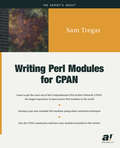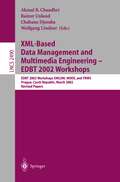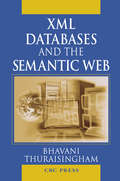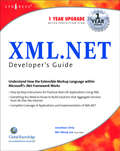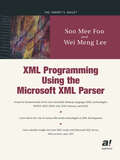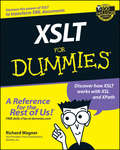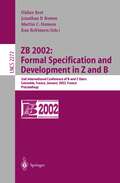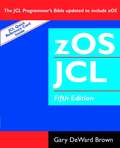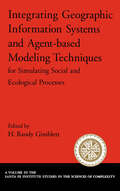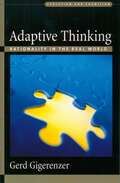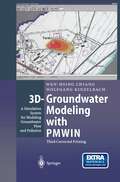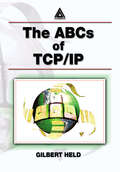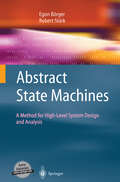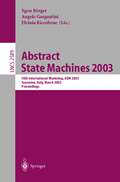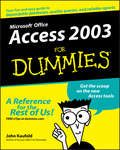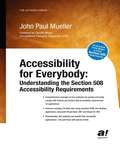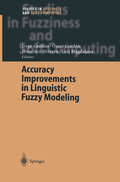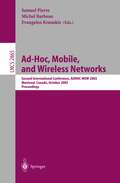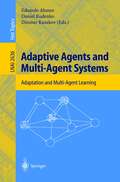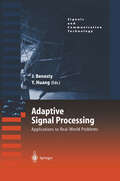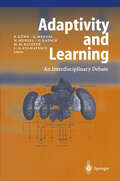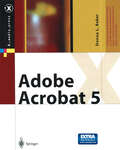- Table View
- List View
Writing Perl Modules for CPAN
by Sam TregarThe author Sam Tregar tells programmers how best to use and contribute modules to the Open Source repository known as CPAN (Comprehensive Perl Archive Network).
XML-Based Data Management and Multimedia Engineering - EDBT 2002 Workshops: EDBT 2002 Workshops XMLDM, MDDE, and YRWS, Prague, Czech Republic, March 24-28, 2002, Revised Papers (Lecture Notes in Computer Science #2490)
by Akmal B. Chaudhri Chabane Djeraba Rainer Unland Wolfgang LindnerThis volume comprises papers from the following three workshops that were part of the complete program for the International Conference on Extending Database Technology (EDBT) held in Prague, Czech Republic, in March 2002: XML-Based Data Management (XMLDM) Second International Workshop on Multimedia Data and Document Engineering (MDDE) Young Researchers Workshop (YRWS) Together, the three workshops featured 48 high-quality papers selected from approximately 130 submissions. It was, therefore, difficult to decide on the papers that were to be accepted for presentation. We believe that the accepted papers substantially contribute to their particular fields of research. The workshops were an excellent basis for intense and highly fruitful discussions. The quality and quantity of papers show that the areas of interest for the workshops are highly active. A large number of excellent researchers are working in relevant fields producing research output that is not only of interest to other researchers but also for industry. The organizers and participants of the workshops were highly satisfied with the output. The high quality of the presenters and workshop participants contributed to the success of each workshop. The amazing environment of Prague and the location of the EDBT conference also contributed to the overall success. Last, but not least, our sincere thanks to the conference organizers – the organizing team was always willing to help and if there were things that did not work, assistance was quickly available.
XML Databases and the Semantic Web
by Bhavani ThuraisinghamEfficient access to data, sharing data, extracting information from data, and making use of the information have become urgent needs for today's corporations. With so much data on the Web, managing it with conventional tools is becoming almost impossible. New tools and techniques are necessary to provide interoperability as well as warehousing betw
XML Net Developers Guide
by SyngressCompete with the big players in today's E-commerce marketplaceElectronic Data Interchange (EDI) has long been the standard for large business enterprises to communicate in the B2B marketplace. However, EDI is a difficult technology - the cost and support of EDI standards is often too much for a small or medium business enterprise to bear. To compete in the current E-commerce marketplace, many organizations are beginning to take an interest in the interoperability that exists between XML (Extensible Markup Language) and EDI. XML .NET Developers Guide is written for information technology professionals responsible for supporting data management in both small and large organizations. This book appeals to both individuals working with an existing EDI environment, and small to medium businesses looking to increase their market presence by competing with current EDI players using XML/EDI.XML/EDI is quickly becoming an industry standard, however there is a noticeable lack of quality reference material for programmers looking to adopt these standards.You can take it with you. The book comes with Syngress' revolutionary Wallet CD containing a printable HTML version of the book, all of the source code, and demo versions of popular XML/EDI translation tools Up to the minute web-based support with solutions@syngress.com
XML Programming Using the Microsoft XML Parser
by Wei-Meng Lee Soo Mee FooXML Programming Using the Microsoft XML Parser is written for programmers interested in XML development using Microsoft technologies. Coupling valuable discussion of the Microsoft XML parser, Windows platform, and XML development software with the numerous core XML technologies, including XSLT, XPATH, SAX, DOM, XML Schema, and SOAP, this book steps beyond the mainstream focus on the theoretical aspects of XML and actually demonstrates the concepts in a real-world development environment. Veteran authors and trainers Soo Mee Foo and Wei Meng Lee intersperse this survey of XML technologies with discussion of topics sure to interest any budding XML developer, providing timely information regarding Web services, ActiveX Data Objects (ADO), and Microsoft SQL Server 2000 XML support. A chapter is also devoted to the Wireless Markup Language (WML), one of the most visible applications of XML technology. No question, XML is one of the rising stars in information technology. XML Programming Using the Microsoft XML Parser offers you what you need to know to get acquainted with the concepts necessary to begin development with this exciting technology.
XSLT For Dummies (For Dummies Ser.)
by Richard WagnerRestructuring information in an XML document so that it works in other formats used to be a time-consuming ordeal involving lots of blood, sweat, and tears. Now XSLT (Extensible Stylesheet Language Transformations) makes the process nearly instantaneous. Just provide an example of the kind of information you’d like to see, and XSLT does the rest. With XSLT you can effortlessly transform XML documents into virtually any kind of output, including other XML documents and HTML pages. But mastering XSLT can be tricky, especially if you’ve never worked with XML or HTML; and most books on the subject are written for people who have. Here comes XSLT For Dummies to the rescue! XSLT For Dummies is your ticket to quickly mastering XSLT—no matter what your prior programming experience. Writing in easygoing, plain English, XML pro Richard Wagner provides expert advice, step-by-step guidance, and tons of crystal-clear examples to help you harness the power of XSLT to transform documen ts. In no time you’ll: Understand how XSLT works with XSL and XPath Experiment with templates, stylesheets, and expressions Perform HTML transformations Master XPath data types and functions Combine XSLT stylesheets Explore cool XSLT programming tricks XSLT For Dummies works from the ground up, starting with a practical introduction of the “X-Team”—XML, XSL, XSLT, and X-Path—and instructions on how to write a XSLT stylesheet. From there it quickly moves onward and upward through the whole range of important XSLT topics, including: Transforming with stylesheets Understanding and using template rules Using XPath to locate nodes in XML documents Combining XSLT stylesheets and adding processing instructions Debugging XSLT transformations Ten XSLT processors available online It doesn’t matter whether you’re a babe in the woods who can’t tell a “tag” from an element, or you’re an old pro at creating XML documents, XSLT For Dummies offers you a fun, easy way to explore and take full advantage of Extensible Stylesheet Language Transformations.
ZB 2002: 2nd International Conference of B and Z Users Grenoble, France, January 23-25, 2002, Proceedings (Lecture Notes in Computer Science #2272)
by Didier Bert Jonathan P. Bowen Martin C. Henson Ken RobinsonzOS JCL (Job Control Language)
by Gary DeWard BrownDiscusses new features provided by zOS, such as improved security, support for Intelligent Resource Director, and support for a 64-bit real storage. Explains how the system configuration in zOS is made easier by a new interface that uses wizards to input desired settings.
Integrating Geographic Information Systems and Agent-Based Modeling Techniques for Simulating Social and Ecological Processes (Santa Fe Institute Studies on the Sciences of Complexity)
by H. Randy GimblettThis volume presents a set of coherent, cross-referenced perspectives on incorporating the spatial representation and analytical power of GIS with agent-based modelling of evolutionary and non-linear processes and phenomena. Many recent advances in software algorithms for incorporating geographic data in modeling social and ecological behaviors, and successes in applying such algorithms, had not been adequately reported in the literature. This book seeks to serve as the standard guide to this broad area.
Adaptive Thinking: Rationality in the Real World (Evolution and Cognition)
by Gerd GigerenzerWhere do new ideas come from? What is social intelligence? Why do social scientists perform mindless statistical rituals? This vital book is about rethinking rationality as adaptive thinking: to understand how minds cope with their environments, both ecological and social. Gerd Gigerenzer proposes and illustrates a bold new research program that investigates the psychology of rationality, introducing the concepts of ecological, bounded, and social rationality. His path-breaking collection takes research on thinking, social intelligence, creativity, and decision-making out of an ethereal world where the laws of logic and probability reign, and places it into our real world of human behavior and interaction. Adaptive Thinking is accessibly written for general readers with an interest in psychology, cognitive science, economics, sociology, philosophy, artificial intelligence, and animal behavior. It also teaches a practical audience, such as physicians, AIDS counselors, and experts in criminal law, how to understand and communicate uncertainties and risks.
Information Technology, Corporate Productivity, and the New Economy
by Stephan KudybaThe authors bring a dual perspective—that of a practicing consultant and that of a professor of economics—to the complex strategic questions facing managers and corporate leaders who want their firms to get the most out of their investments in information technology. The information economy is built upon the myriad and sometimes unforeseen ways in which information technologies have become engines of productivity in themselves, rather than just fancy adjuncts. In explaining the rise of the information economy, the authors provide not only valuable context often missing from today's discussions but also a thorough understanding of the origination, development, and diffusion process of innovations. They also examine prevailing practices and implications for the future, including the potential pitfalls common to some information technology strategies.Relying on an underpinning of economic theory combined with heavy empirical analysis, Kudyba and Diwan describe the true nature of the information economy, paying as much attention to its particularities as to its more profound implications. How is information technology being implemented across industry sectors, and how can it be harnessed to improve overall firm-level productivity? How have innovations in high technology impacted e-commerce? Which e-commerce strategies prevail, and what can be expected of them? How can traditional economic theory help managers evaluate such in-vogue strategies as customer relationship management, market exchanges, and supply chain management? The authors answer these questions and more, including one of the most vexing in the short history of e-commerce: What led to the demise of so many technology stocks and dot-coms following the spring 2000 Nasdaq plunge, and what are the longer-term prospects for e-business?
Information Technology Strategies: How Leading Firms Use IT to Gain an Advantage
by William V. RappThe focus of this book is to educate the reader on the strategic principles fundamental to using information technology to gain market control. It provides case examples of how to use IT to enhance existing core competencies and strategies. The book is designed to help managers struggling with how to advantageously harness the new information revolution. It can also support executive and business education programs on managing technology when few such studies exist. While Internet and information technologies are currently hot topics many firms and executives are without the tools and know-how of how to actually use them to improve results. Some major firms have sophisticated strategies for using information technology to impact, control and even own their competitive environments. This book describes how major non-information technology companies are doing this and the strategic principles employed.
3D-Groundwater Modeling with PMWIN: A Simulation System for Modeling Groundwater Flow and Pollution
by Wen-Hsing Chiang Wolfgang KinzelbachThis book and CD-ROM offer a complete simulation system for modeling groundwater flow and transport processes. The companion full-version software (PMWIN) comes with a professional graphical user-interface, supported models and programs and several other useful modeling tools. Tools include a Presentation Tool, a Result Extractor, a Field Interpolator, a Field Generator, a Water Budget Calculator and a Graphic Viewer. Book and CD-ROM are targeted at novice and experienced groundwater modelers.
The ABCs of TCP/IP
by Gilbert HeldThe TCP/IP protocol suite is changing dynamically to reflect advances in technology and can be considered to represent the "protocol for the new millenium." The ABCs of TCP/IP reflects these advances and includes new coverage on: Secure Web transactions Practical subnetting examplesSecurity threats and counterm
Abstract State Machines: A Method for High-Level System Design and Analysis
by Egon Börger Robert StärkAbstract State Machines 2003: 10th International Workshop, ASM 2003, Taormina, Italy, March 3-7, 2003. Proceedings (Lecture Notes in Computer Science #2589)
by Egon Börger Angelo Gargantini Elvinia RiccobeneThis book constitutes the refereed proceedings of the 10th International Workshop on Abstract State Machines, ASM 2003, held in Taormina, Italy in March 2003. The 16 revised full papers presented together with 8 invited papers and 12 abstracts were carefully reviewed and selected for inclusion in the book. The papers reflect the state of the art of the abstract state machine method for the design and analysis of complex software/hardware systems. Besides theoretical results and methodological progress, application in various fields are studied as well.
Access 2003 For Dummies (For Dummies Ser.)
by John KaufeldWhen you hear the word “database,” do your eyes glaze over? Does the mention of fields and tables make your blood pressure skyrocket? Does the idea of entering and using hyperlinks make you hyperventilate? Whether you’re running a business or a household . . . whether you need to be able to quickly access customer information, your recipe for chicken cacciatore, or the Little League team’s records, Access 2003 holds the key. This friendly guide unlocks the secrets of using Access 2003 to store, manage, organize, reorganize, and use data! It gives you: The basics of the whole database concept Suggestions for solving problems with Access What you need to know to design, build, use, and change Access tables Info on the ten most common types of fields The scoop on using queries to unearth the answers hiding somewhere in your data Guidelines for using the Access report system to make short work of long, previously time-consuming, reports In the relaxed, comfortable For Dummies style, this book has easy-to-follow, step-by-step instructions and lots of screen shots. If you want to create and manage a database for a huge auction house, this guide will get you going . . . going . . . gone. If you want to create a database for your music collection, it gives you the score then shows you how to use formatting and add graphics to jazz it up. You’ll get the low-down on extracting all kinds of information from databases and putting that information to practical use. You’ll discover how to: Use Label Wizard to create mailing labels, file labels, shipping labels, or name tags Use Chart Wizard to create line charts, bar, cone, and column charts, pie and donut charts, area charts, and XY and bubble charts Use Auto Reports to create columnar or tabular reports and then fine-tune them Export reports to Microsoft Word and Excel Get your data Web-ready and put it on the Internet in either static or dynamic form Build forms with Form Wizard And speaking of high-tech fun, Access 2003 For Dummies even tells you how to install and use speech recognition software with Access 2003. So if the idea of working with databases has you talking to yourself, this is just the book you need.
Access 2003 For Dummies
by John KaufeldWhen you hear the word “database,” do your eyes glaze over? Does the mention of fields and tables make your blood pressure skyrocket? Does the idea of entering and using hyperlinks make you hyperventilate? Whether you’re running a business or a household . . . whether you need to be able to quickly access customer information, your recipe for chicken cacciatore, or the Little League team’s records, Access 2003 holds the key. This friendly guide unlocks the secrets of using Access 2003 to store, manage, organize, reorganize, and use data! It gives you: The basics of the whole database concept Suggestions for solving problems with Access What you need to know to design, build, use, and change Access tables Info on the ten most common types of fields The scoop on using queries to unearth the answers hiding somewhere in your data Guidelines for using the Access report system to make short work of long, previously time-consuming, reports In the relaxed, comfortable For Dummies style, this book has easy-to-follow, step-by-step instructions and lots of screen shots. If you want to create and manage a database for a huge auction house, this guide will get you going . . . going . . . gone. If you want to create a database for your music collection, it gives you the score then shows you how to use formatting and add graphics to jazz it up. You’ll get the low-down on extracting all kinds of information from databases and putting that information to practical use. You’ll discover how to: Use Label Wizard to create mailing labels, file labels, shipping labels, or name tags Use Chart Wizard to create line charts, bar, cone, and column charts, pie and donut charts, area charts, and XY and bubble charts Use Auto Reports to create columnar or tabular reports and then fine-tune them Export reports to Microsoft Word and Excel Get your data Web-ready and put it on the Internet in either static or dynamic form Build forms with Form Wizard And speaking of high-tech fun, Access 2003 For Dummies even tells you how to install and use speech recognition software with Access 2003. So if the idea of working with databases has you talking to yourself, this is just the book you need.
Accessibility for Everybody: Understanding the Section 508 Accessibility Requirements
by John MuellerIn today's rapidly changing technological world, it is increasingly important that web and desktop applications be accessible to everyone, including those of us with special needs. However, the legal requirements for accessibility are often convoluted and diffucult to understand, making it impossible for most developers to comply with the laws. In the first book on the market to address the topic, Author John Paul Mueller leads you through the maze of Section 508—the congressional law ensuring that all Americans have access to information technology—and offers comprehensive guidance on how to quickly and easily update your applications to conform to Section 508 requirements. To begin, Mueller outlines the Section 508 requirements that are relevant to web and desktop application developers, and explains the laws in language you can understand. Using extensive and varied program examples, Mueller continues on to teach you to write web and desktop applications that not only conform to Section 508 standards, but look forward to ensure long-term universal accessibility for all types of computer users. Specific topics include writing accessible web applications and desktop applications using Visual Basic .NET and Visual C# .NET, developing special application capabilities, using Microsoft and other third-party tools to develop accessible features, developing accessible scripting solutions, and more. The book even includes a directory of helpful organizations, agencies, and resources to help you with any further accessibility concerns you may have.
Accuracy Improvements in Linguistic Fuzzy Modeling (Studies in Fuzziness and Soft Computing #129)
by Francisco Herrera Triguero Luis Magdalena Jorge Casillas O. CordónFuzzy modeling usually comes with two contradictory requirements: interpretability, which is the capability to express the real system behavior in a comprehensible way, and accuracy, which is the capability to faithfully represent the real system. In this framework, one of the most important areas is linguistic fuzzy modeling, where the legibility of the obtained model is the main objective. This task is usually developed by means of linguistic (Mamdani) fuzzy rule-based systems. An active research area is oriented towards the use of new techniques and structures to extend the classical, rigid linguistic fuzzy modeling with the main aim of increasing its precision degree. Traditionally, this accuracy improvement has been carried out without considering the corresponding interpretability loss. Currently, new trends have been proposed trying to preserve the linguistic fuzzy model description power during the optimization process. Written by leading experts in the field, this volume collects some representative researcher that pursue this approach.
Ad-Hoc, Mobile, and Wireless Networks: Second International Conference, ADHOC-NOW 2003, Montreal, Canada, October 8-10, 2003, Proceedings (Lecture Notes in Computer Science #2865)
by Samuel Pierre Michel Barbeau Evangelos KranakisAdaptive Agents and Multi-Agent Systems: Adaptation and Multi-Agent Learning (Lecture Notes in Computer Science #2636)
by Eduardo Alonso Daniel Kudenko Dimitar KazakovAdaptive Agents and Multi-Agent Systems is an emerging and exciting interdisciplinary area of research and development involving artificial intelligence, computer science, software engineering, and developmental biology, as well as cognitive and social science. This book surveys the state of the art in this emerging field by drawing together thoroughly selected reviewed papers from two related workshops; as well as papers by leading researchers specifically solicited for this book. The articles are organized into topical sections on - learning, cooperation, and communication - emergence and evolution in multi-agent systems - theoretical foundations of adaptive agents
Adaptive Signal Processing: Applications to Real-World Problems (Signals and Communication Technology)
by Jacob Benesty Yiteng HuangFor the first time, a reference on the most relevant applications of adaptive filtering techniques. Top researchers in the field contributed chapters addressing applications in acoustics, speech, wireless and networking, where research is still very active and open.
Adaptivity and Learning: An Interdisciplinary Debate
by Reimer Kühn Randolf Menzel Wolfram Menzel Ulrich Ratsch Michael M. Richter Ion-Olimpiu StamatescuAdaptivity and learning have in recent decades become a common concern of scientific disciplines. These issues have arisen in mathematics, physics, biology, informatics, economics, and other fields more or less simultaneously. The aim of this publication is the interdisciplinary discourse on the phenomenon of learning and adaptivity. Different perspectives are presented and compared to find fruitful concepts for the disciplines involved. The authors select problems showing representative traits concerning the frame up, the methods and the achievements rather than to present extended overviews.
Adobe Acrobat 5 (X.media.press)
by Donna L. BakerMit Adobe Acrobat 5 können fast alle Dokumente, von Word-Dateien über Grafiken, bis zu Textdokumenten mit Grafiken in PDF gespeichert, per E-Mail verschickt und auf Web-Sites veröffentlicht werden. Donna L. Baker stellt die Eigenschaften und Tools von Adobe Acrobat 5 für professionelle User ausführlich dar und unterstützt deren Arbeit mit vielen Tipps zur Optimierung des Workflows und zur effektiven Benutzung der Software. Anhand eines Beispiels beschreibt sie das Projektmanagement von der Projektplanung bis zum Design-Prozess. Ein Kapitel über Acrobat JavaScript rundet das Werk ab. Die CD-ROM enthält die dargestellten Projekte und Tutorials und weitere Hinweise zu Adobe Acrobat Anwendungen (in Englisch).
